Summary: in this tutorial, you will learn about the SQL Server subquery and how to use the subquery for querying data.
Introduction to SQL Server subquery
A subquery is a query nested inside another statement such as SELECT, INSERT, UPDATE, or DELETE.
Let’s see the following example.
Consider the orders and customers tables from the sample database.
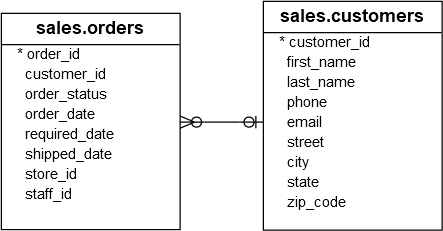
The following statement shows how to use a subquery in the WHERE clause of a SELECT statement to find the sales orders of the customers located in New York:
SELECT
order_id,
order_date,
customer_id
FROM
sales.orders
WHERE
customer_id IN (
SELECT
customer_id
FROM
sales.customers
WHERE
city = 'New York'
)
ORDER BY
order_date DESC;
Code language: SQL (Structured Query Language) (sql)Here is the result:
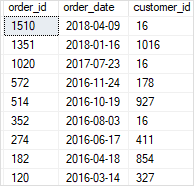
In this example, the following statement is a subquery:
SELECT
customer_id
FROM
sales.customers
WHERE
city = 'New York'
Code language: SQL (Structured Query Language) (sql)Note that you must always enclose the SELECT query of a subquery in parentheses ().
A subquery is also known as an inner query or inner select, while the statement containing the subquery is called an outer select or outer query:
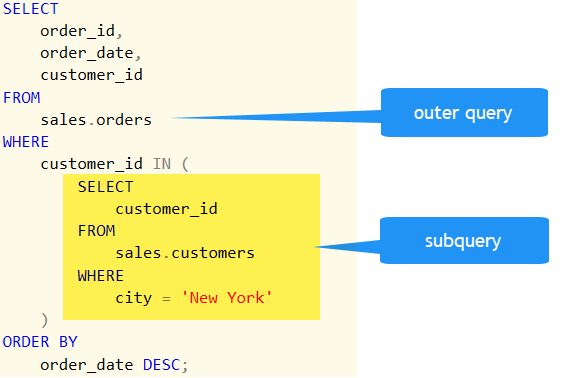
SQL Server executes the whole query example above as follows:
First, it executes the subquery to get a list of customer identification numbers of the customers located in New York.
SELECT
customer_id
FROM
sales.customers
WHERE
city = 'New York'
Code language: SQL (Structured Query Language) (sql)
Second, SQL Server substitutes customer identification numbers returned by the subquery in the IN operator and executes the outer query to get the final result set.
As you can see, by using the subquery, you can combine two steps. The subquery removes the need for selecting the customer identification numbers and plugging them into the outer query. Moreover, the query itself automatically adjusts whenever the customer data changes.
Nesting subquery
A subquery can be nested within another subquery. SQL Server supports up to 32 levels of nesting. Consider the following example:
SELECT
product_name,
list_price
FROM
production.products
WHERE
list_price > (
SELECT
AVG (list_price)
FROM
production.products
WHERE
brand_id IN (
SELECT
brand_id
FROM
production.brands
WHERE
brand_name = 'Strider'
OR brand_name = 'Trek'
)
)
ORDER BY
list_price;
Code language: SQL (Structured Query Language) (sql)
First, SQL Server executes the following subquery to get a list of brand identification numbers of the Strider and Trek brands:
SELECT
brand_id
FROM
production.brands
WHERE
brand_name = 'Strider'
OR brand_name = 'Trek';
Code language: SQL (Structured Query Language) (sql)
Second, SQL Server calculates the average price list of all products that belong to those brands.
SELECT
AVG (list_price)
FROM
production.products
WHERE
brand_id IN (6,9)
Code language: SQL (Structured Query Language) (sql)Third, SQL Server finds the products whose list price is greater than the average list price of all products with the Strider or Trek brand.
SQL Server subquery types
You can use a subquery in many places:
- In place of an expression
- With
INorNOT IN - With
ANYorALL - With
EXISTSorNOT EXISTS - In
UPDATE,DELETE, orINSERTstatement - In the
FROMclause
SQL Server subquery is used in place of an expression
If a subquery returns a single value, it can be used anywhere an expression is used.
In the following example, a subquery is used as a column expression named max_list_price in a SELECT statement.
SELECT
order_id,
order_date,
(
SELECT
MAX (list_price)
FROM
sales.order_items i
WHERE
i.order_id = o.order_id
) AS max_list_price
FROM
sales.orders o
order by order_date desc;
Code language: SQL (Structured Query Language) (sql)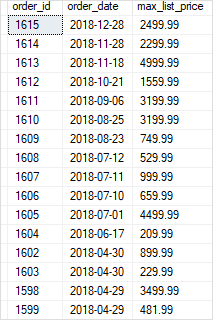
SQL Server subquery is used with IN operator
A subquery that is used with the IN operator returns a set of zero or more values. After the subquery returns values, the outer query makes use of them.
The following query finds the names of all mountain bikes and road bikes products that the Bike Stores sell.
SELECT
product_id,
product_name
FROM
production.products
WHERE
category_id IN (
SELECT
category_id
FROM
production.categories
WHERE
category_name = 'Mountain Bikes'
OR category_name = 'Road Bikes'
);
Code language: SQL (Structured Query Language) (sql)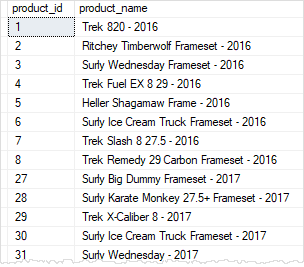
This query is evaluated in two steps:
- First, the inner query returns a list of category identification numbers that match the names
Mountain BikesandcodeRoad Bikes. - Second, these values are substituted into the outer query that finds the product names which have the category identification number match with one of the values in the list.
SQL Server subquery is used with ANY operator
The subquery is introduced with the ANY operator has the following syntax:
scalar_expression comparison_operator ANY (subquery)
Code language: SQL (Structured Query Language) (sql)Assuming that the subquery returns a list of value v1, v2, … vn. The ANY operator returns TRUE if one of a comparison pair (scalar_expression, vi) evaluates to TRUE; otherwise, it returns FALSE.
For example, the following query finds the products whose list prices are greater than or equal to the average list price of any product brand.
SELECT
product_name,
list_price
FROM
production.products
WHERE
list_price >= ANY (
SELECT
AVG (list_price)
FROM
production.products
GROUP BY
brand_id
)
Code language: SQL (Structured Query Language) (sql)
For each brand, the subquery finds the maximum list price. The outer query uses these max prices and determines which individual product’s list price is greater than or equal to any brand’s maximum list price.
SQL Server subquery is used with ALL operator
The ALL operator has the same syntax as the ANY operator:
scalar_expression comparison_operator ALL (subquery)
Code language: SQL (Structured Query Language) (sql)The ALL operator returns TRUE if all comparison pairs (scalar_expression, vi) evaluate to TRUE; otherwise, it returns FALSE.
The following query finds the products whose list price is greater than or equal to the average list price returned by the subquery:
SELECT
product_name,
list_price
FROM
production.products
WHERE
list_price >= ALL (
SELECT
AVG (list_price)
FROM
production.products
GROUP BY
brand_id
)
Code language: SQL (Structured Query Language) (sql)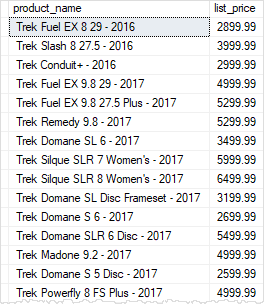
SQL Server subquery is used with EXISTS or NOT EXISTS
The following illustrates the syntax of a subquery introduced with EXISTS operator:
WHERE [NOT] EXISTS (subquery)
Code language: SQL (Structured Query Language) (sql)The EXISTS operator returns TRUE if the subquery return results; otherwise, it returns FALSE.
The NOT EXISTS negates the EXISTS operator.
The following query finds the customers who bought products in 2017:
SELECT
customer_id,
first_name,
last_name,
city
FROM
sales.customers c
WHERE
EXISTS (
SELECT
customer_id
FROM
sales.orders o
WHERE
o.customer_id = c.customer_id
AND YEAR (order_date) = 2017
)
ORDER BY
first_name,
last_name;
Code language: SQL (Structured Query Language) (sql)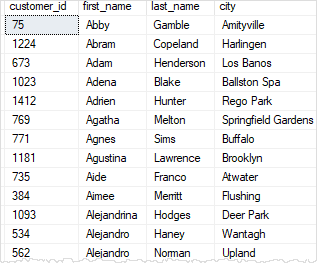
If you use the NOT EXISTS instead of EXISTS, you can find the customers who did not buy any products in 2017.
SELECT
customer_id,
first_name,
last_name,
city
FROM
sales.customers c
WHERE
NOT EXISTS (
SELECT
customer_id
FROM
sales.orders o
WHERE
o.customer_id = c.customer_id
AND YEAR (order_date) = 2017
)
ORDER BY
first_name,
last_name;
Code language: SQL (Structured Query Language) (sql)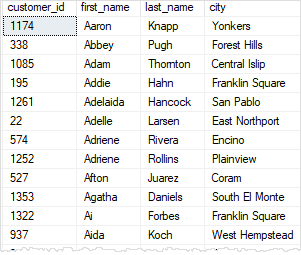
SQL Server subquery in the FROM clause
Suppose that you want to find the average of the sum of orders of all sales staff. To do this, you can first find the number of orders by staff:
SELECT
staff_id,
COUNT(order_id) order_count
FROM
sales.orders
GROUP BY
staff_id;Code language: SQL (Structured Query Language) (sql)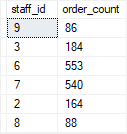
Then, you can apply the AVG() function to this result set. Since a query returns a result set that looks like a virtual table, you can place the whole query in the FROM clause of another query like this:
SELECT
AVG(order_count) average_order_count_by_staff
FROM
(
SELECT
staff_id,
COUNT(order_id) order_count
FROM
sales.orders
GROUP BY
staff_id
) t;Code language: SQL (Structured Query Language) (sql)
The query that you place in the FROM clause must have a table alias. In this example, we used the t as the table alias for the subquery. To come up with the final result, SQL Server carries the following steps:
- Execute the subquery in the
FROMclause. - Use the result of the subquery and execute the outer query.
In this tutorial, you have learned about the SQL Server subquery concept and how to use various subquery types to query data.